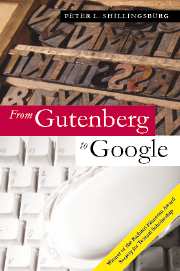Book contents
- Frontmatter
- Contents
- Introduction
- 1 Manuscript, book, and text in the twenty-first century
- 2 Complexity, endurance, accessibility, beauty, sophistication, and scholarship
- 3 Script act theory
- 4 An electronic infrastructure for representing script acts
- 5 Victorian fiction: shapes shaping reading
- 6 The dank cellar of electronic texts
- 7 Negotiating conflicting aims in textual scholarship
- 8 Hagiolatry, cultural engineering, monument building, and other functions of scholarly editing
- 9 The aesthetic object: “the subject of our mirth”
- 10 Ignorance in literary studies
- Bibliography
- Index
1 - Manuscript, book, and text in the twenty-first century
Published online by Cambridge University Press: 23 December 2009
- Frontmatter
- Contents
- Introduction
- 1 Manuscript, book, and text in the twenty-first century
- 2 Complexity, endurance, accessibility, beauty, sophistication, and scholarship
- 3 Script act theory
- 4 An electronic infrastructure for representing script acts
- 5 Victorian fiction: shapes shaping reading
- 6 The dank cellar of electronic texts
- 7 Negotiating conflicting aims in textual scholarship
- 8 Hagiolatry, cultural engineering, monument building, and other functions of scholarly editing
- 9 The aesthetic object: “the subject of our mirth”
- 10 Ignorance in literary studies
- Bibliography
- Index
Summary
… the immutable condition of written statements: in writing down a message, one brings down an abstraction to the concrete, where it is an alien, damaged here and there through the intractability of the physical.
Tanselle, Rationale of Textual Criticism (1989)… the physical embodiment of text is not in itself the sign that text has been “damaged,” or that we have entered a world of “intractable” materialities … The textual condition's only immutable law is the law of change … [that] declares that these histories will exhibit a ceaseless process of textual development and mutation …
McGann, The Textual Condition (1991)In spite of a suspicion of widespread techno-enthusiasm, I have confidence and hope in the electronic textual revolution. My hopes are based in part on recent innovations in hardware and software, on the developing capabilities of and the improving appearance of electronic texts, and, more important, on the types of questions that are being asked about texts and about what to do with them. Developments in editorial theory have put in question the whole purpose for editions and the concepts of how editions should take shape and function. Together these elements made real progress possible, I think.
It is easy to get lost or discouraged in the field of electronic texts. Every new whoop-tee-doo in these areas soon becomes last week's news in the face of even newer ones.
Information
- Type
- Chapter
- Information
- From Gutenberg to GoogleElectronic Representations of Literary Texts, pp. 11 - 24Publisher: Cambridge University PressPrint publication year: 2006
